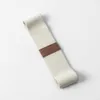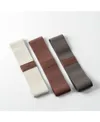
Every so often, I get up out of my chair, roll out one of the best yoga mats, and begin moving my body. Sometimes, I know what exercises I’m going to do, but other times, I just move intuitively. Once I’m finished, my muscles feel stronger and longer, and my joints looser. It’s what gives me physical and mental clarity and calm when I’m writing at my desk all day at home.
One routine I recently produced is a five-move mobility flow that helps to unlock your joints and stretch tight muscles. It should make you feel like you’re gliding along your mat, and hopefully, leave you feeling calmer. Here's exactly how you can follow it as well.
Watch Sam's mobility flow routine:
This routine features five exercises, which you’ll do for two sets and 6-8 reps each. To make it feel more “flowy,” I recommend moving through each of the exercises without rest for one set, then repeating for the second. If you prefer, you could complete each exercise one at a time.
Leg openers
The first exercise is the leg opener. It helps open your hips and groin and stretches out the adductor muscles, while also strengthening the hip flexors that help you to lift your legs into the air.
Try to move slowly and with control; leg openers are tough, so you’ll be tempted to open and close your leg as quickly as you can. Keep your feet flexed at all times to help engage the back of the leg, and open as far as you can without dropping down.
Once you feel more comfortable with the exercise, see if you can place a block or dumbbell to one side and raise your leg over it and back again for an extra challenge.
The biggest mistake I see with this exercise is a lack of activity in the torso. Avoid hunching over or collapsing into your upper body. You can use a wall to begin with or place your hands down by your sides for support. If I positioned a pole behind you, your entire spine should be able to make contact with it.
Get instant access to breaking news, the hottest reviews, great deals and helpful tips.
A post shared by Sam (@sam_stretchstrongco)
A photo posted by on
Roll up and fold
I’m no Pilates teacher, so I won’t try to be. This is a variation on the Pilates roll-up exercise, working your core muscles to help you sit up, then stretching down your entire back and hamstrings as you fold over your legs in a seated position.
Try to keep your legs still and the backs of your legs pressed into the mat at all times. Engaging your core and preventing your hips from taking over should help with this. Again, move up and down with control, inhaling as you reach your arms overhead while lying down, then exhaling as you sit up and fold over your legs. Stay in the stretch for a moment, as this is when your hamstrings and back get a deep release.
As you lower your back, create tension in your abs to help you control the descent back to the floor. This is the perfect time to engage with your breath, so try to move intuitively with it and flow from one position to the other.
Loaded beast
Ask anyone I train and they’ll tell you that I feature this exercise in most of my lower-body workouts and mobility classes. Unlike the bear squat (which looks similar), this exercise is derived from animal flow and engages more of the body than just the legs.
As you sit your hips back toward your heels, I want you to imagine coiling a spring; this improves ankle, hip and knee mobility. Then, explode forward as you push over your wrists and work more into your front body, chest and shoulders.
This move is great for developing full-body mobility, but also strengthens your core muscles for stability. Try to sit further back into your heels each time, and for an extra challenge, place a barbell plate on your mid-to-upper back.
Lateral shoot throughs
Perhaps my favorite exercise of the five, lateral shoot throughs use rotational movement to engage the core, including your obliques that run along your waist. Again, it’s a full-body exercise, but also teaches balance, stability and coordination.
Move with full control as you kick your leg under and lift the opposite arm to the air, opening the chest and shoulders as much as you can. Notice in the video that my gaze follows my top hand, and try to do the same.
A common mistake I see here is positioning the hand too far in front of the shoulder. Start in a tabletop position with your shoulders stacked over your wrists, then hover your knees above the floor, which should help you find a strong starting position to move from. Always come back to this place before moving to the other side.
Downward dog to upward dog
Two classic yoga poses fused together, what better way to round off this routine?
The transition from down to updog should feel smooth and flowing as you move; come through to plank, then dip the hips into updog and untuck your toes.
Try to keep your shoulders pulled down away from your ears and avoid hunching so that you can release properly through your spine. If this feels too intense on your lower back, walk your hands further away from you or come down onto your elbows.
Remember, the time spent on your mat isn’t a flexibility competition with anyone else. Focus on moving in a way that feels good for your body, and don’t force anything. I recommend a relaxing, mood-boosting playlist and a quiet space that you can flow in without distraction.

Follow Tom's Guide on Google News and add us as a preferred source to get our up-to-date news, analysis, and reviews in your feeds.
More from Tom's Guide
- I asked a personal trainer for the best full-body workout you can do without any weights — here’s what they sent
- Forget squats — this 20-minute chair yoga routine sculpts stronger legs and core muscles without weights
- 5 chair exercises that build functional strength after 50 — and they're beginner-friendly

Sam Hopes is a level 3 qualified trainer, a level 2 Reiki practitioner and fitness editor at Tom's Guide. She is also currently undertaking her Yoga For Athletes training course.
Sam has written for various fitness brands and websites over the years and has experience across brands at Future, such as Live Science, Fit&Well, Coach, and T3.
Having coached at fitness studios like F45 and Virgin Active and personal trained, Sam now primarily teaches outdoor bootcamps, bodyweight, calisthenics and kettlebells.
She also coaches mobility and flexibility classes several times a week and believes that true strength comes from a holistic approach to training your body.
Sam has completed two mixed doubles Hyrox competitions in London and the Netherlands and finished her first doubles attempt in 1:11.
You must confirm your public display name before commenting
Please logout and then login again, you will then be prompted to enter your display name.










